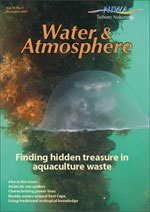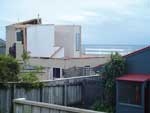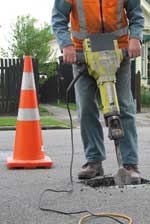PDF of this article (123 KB)

Learning from the Taranaki tornadoes

In early July, a swarm of tornadoes cut a 140-km swathe of destruction across the Taranaki region. The first tornado hit the New Plymouth CBD on the 4th, damaging several businesses, a few residential dwellings, and a racecourse. However, much more dramatic events were to follow on the next day, when a swarm of several – possibly more than 20 – tornadoes struck locations throughout Taranaki and devastated the small coastal town of Oakura. Roughly 50 houses suffered major damage, some of it irreparable, when two tornadoes ripped through the town.
In response to the tornadoes, NIWA organised a multi agency reconnaissance team to assess the vulnerability of different types of New Zealand buildings (domestic and commercial) to high winds. Besides making visual observations and detailed measurements of the level of damage, we interviewed eyewitnesses, property owners, and local emergency managers. We used GPS equipment to record the exact location of the surveyed buildings, and prepared survey forms to ensure a consistent and objective assessment. After collating the damage for each tornado path, we estimated the tornado category (F-scale) and the likely wind speeds.
Our objective for the survey is to develop wind fragility or vulnerability curves that match a given wind exposure (gust velocity) to a realistic level of damage to different types of New Zealand buildings (for example, timber, masonary, or brick veneer). A report on this survey will soon be available on the Natural Hazards Centre website: www.naturalhazards.net.nz
For further information, contact: Dr Stefan Reese, 04-386 0564, [email protected]
Dealing to contaminated Christchurch roads


Chemists at NIWA are working with Fulton Hogan roading contractors in a project to immobilise and remedy coal-tar contamination in the city’s network of streets. We’re trialling an innovative solution using established in-situ recycling methods.
Gas works are well known for being highly contaminated sites, and recently the problem of how to deal with contaminated fill material from gas works has emerged. However, it’s less well known that similar coal tar products were widely used for tar sealing New Zealand roads before the 1970s. Compared to the bitumen used in road construction today, coal tar contained about 5000 times greater concentrations of the carcinogenic contaminants polycyclic aromatic hydrocarbons, or PAHs.
Approximately half of Christchurch’s streets are contaminated with coal tar. Many are nearing the end of their operational life times and will require complete reconstruction within the next 20 years. However, excavating and disposing of the many thousands of tonnes of contaminated roading material will be prohibitively expensive.
Our research project is examining the feasibility of using established in-situ recycling methods to solve the problem of coal tar legacy in older roads. The method we’re testing involves milling the road surface and base material, while simultaneously adding ‘foamed’ bitumen. The resulting pulverised (or milled) road is shaped and compacted to form the new road base material, which is then overlaid with a new bitumen surface seal.
A key component of the research is to establish whether the in-situ method can adequately immobilise the PAH contaminants from the coal tar. To this end, we’ll run leaching and toxicity tests on stabilised road millings prepared with specialist equipment that mimics the exact process used in the large recycling/stabilisation machines operated by Fulton Hogan. The project will culminate next year in a full field trial on an 80-m section of Burke Street in Christchurch.
Funding for the project comes from Land Transport New Zealand and Christchurch City Council.
For further information, contact: Dr Craig Depree, 0-7-856 1750, [email protected]
You can read more about this research in ‘Environmental forensics: cracking the case of the contaminated streams’, Water & Atmosphere 15(3): 8–9.
